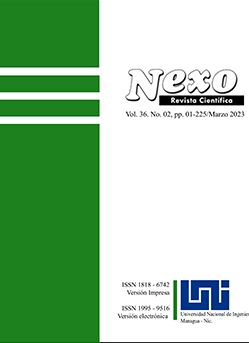Design of bio-inspired irregular porous structure applied to intelligent mobility products
DOI:
https://doi.org/10.5377/nexo.v36i02.16018Keywords:
Biomimetic design, Porous structure, Tissue engineering, Additive manufacturing, VoronoiAbstract
Material structure is a crucial part of the design of any product where the intention is to dissipate loads and lighten material. Because some structures today are increasingly complex in geometry and internal structure, it becomes impossible to opt for traditional methods to manufacture them. In this sense, additive manufacturing enables the creation of complex structures with intricate geometries. As manufacturers seek to optimize material properties and performance in a variety of stress conditions, bio-inspired engineering looks at nature for solving the most complex human challenges. By imitating nature’s patterns and shapes, we can optimize fracture resistance, energy absorption, and toughness in materials. In this work, we employ voronoi tessellation patterns and computer-aided design software to design an algorithm for the creation of irregular porous structures, similar to those found in nature (e.g., trabecular bone). This algorithm is scalable and applicable to any product that needs to comply with lightweight requirements and outstanding mechanical properties. Herein, the authors perform static compression tests to determine mechanical properties. The results indicated that the mechanical properties depend directly on the microstructural characteristics of the porous structure itself. Besides, surface area and porosity are the principal parameters to be controlled. Finally, the algorithm has a wide range of engineering applications in the automotive and aerospace industries.
Downloads
1615
PDF 259
Published
How to Cite
Issue
Section
License
Copyright (c) 2023 Universidad Nacional de Ingeniería

This work is licensed under a Creative Commons Attribution 4.0 International License.
The authors who publish in Nexo Scientific Journal agree to the following terms:
- Authors retain the copyright and grant the journal the right of the first publication under the license Creative Commons Attribution License, which allows others to share the work with a recognition of the authorship of the work and the initial publication in Nexo Scientific Journal.
- Authors may separately establish additional agreements for the non-exclusive distribution of the version of the work published in the journal (for example, in an institutional repository or a book), with the recognition of the initial publication in Nexo Scientific Journal.
- Authors are allowed and encouraged to disseminate their works electronically (for example, in institutional repositories or in their own website) before and during the submission process, as it can lead to productive exchanges, as well as earlier and greater citation of published works.










